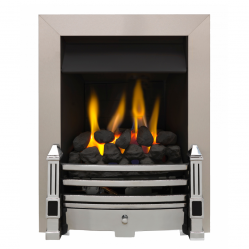Technical Details
| Product Title | Paragon 2000 Plus Manual Control Engine Only, N.Gas, Coal Effect |
|---|---|
| Product Keyword | Paragon 2000 Plus Engine, Manual Control Gas Fire, Natural Gas, Coal Effect Fire, Replacement Gas Engine |
| Energy Efficiency | F |
| Output (Nominal) | 3.6kW |
| Output (Maximum) | 4kW |
| Fuel | Gas - NG |
| Height | 554mm |
| Width | 372mm |
| Depth | 172mm |
| Nominal Output (Range) | 3kW - 5kW |
| Width (Range) | 300mm - 400mm |
| Nett Efficiency (%) | 56% |
| Style | Traditional |
| Chimney Type | Class 1 & 2 |
| Height (Range) | 500mm - 600mm |
Product Description
Paragon 2000 Plus Manual Control Engine – Natural Gas, Coal Effect
Experience the warm and inviting ambiance of a traditional fireplace with the Paragon 2000 Plus Manual Control Engine. Designed exclusively for use with natural gas, this unit is perfect for creating a cozy atmosphere in your home. The realistic coal effect adds a touch of authenticity to your fireplace.
- Model: Paragon 2000 Plus Manual Control Engine
- Fuel Type: Natural Gas (N.Gas)
- Realistic Coal Effect: Enjoy the traditional look of a coal-burning fire
- Control Type: Manual for easy operation
- High Efficiency: Optimize your heating and energy use
- Safety Features: Comes with standard safety protocols for peace of mind
- Installation: Suitable for a variety of fireplace openings
- Design: Sleek and unobtrusive, blends seamlessly with your decor
- Maintenance: Low maintenance requirements for hassle-free use
File Downloads
Reviews
Gas Fires > Gas Fires for a Class 1 Chimney

Gas Fires for a Class 1 Chimney
A class 1 chimney is a brick or stone-built chimney and is commonly found in houses built prior to 1930. These types of chimney are easily recognisable by the top of the chimney stack (and chimney pot) extending higher than the roof line which creates the draw. Here, we have displayed our range of gas fires suitable for a class 1 chimney, many of which are available with different effects, such as coal or logs, and with different finishes to better suit the interior décor. A gas certified liner will be required to line the chimney, to prevent the escape of any toxic gases into the house. This is largely due to the likely condition of the chimney stack, as these have commonly been used for open fires in the past and so the risk of damage and leakages is extremely high. A class 1 chimney can also be determined by the presence or lack of a constructional hearth- although this is not always necessary in relation to certain gas appliances (i.e. sealed gas appliances).





